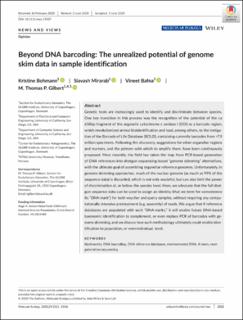| dc.description.abstract | Genetic tools are increasingly used to identify and discriminate between species. One key transition in this process was the recognition of the potential of the ca 658bp fragment of the organelle cytochrome c oxidase I (COI) as a barcode region, which revolutionized animal bioidentification and lead, among others, to the instigation of the Barcode of Life Database (BOLD), containing currently barcodes from >7.9 million specimens. Following this discovery, suggestions for other organellar regions and markers, and the primers with which to amplify them, have been continuously proposed. Most recently, the field has taken the leap from PCR-based generation of DNA references into shotgun sequencing-based “genome skimming” alternatives, with the ultimate goal of assembling organellar reference genomes. Unfortunately, in genome skimming approaches, much of the nuclear genome (as much as 99% of the sequence data) is discarded, which is not only wasteful, but can also limit the power of discrimination at, or below, the species level. Here, we advocate that the full shotgun sequence data can be used to assign an identity (that we term for convenience its “DNA-mark”) for both voucher and query samples, without requiring any computationally intensive pretreatment (e.g. assembly) of reads. We argue that if reference databases are populated with such “DNA-marks,” it will enable future DNA-based taxonomic identification to complement, or even replace PCR of barcodes with genome skimming, and we discuss how such methodology ultimately could enable identification to population, or even individual, level | en_US |

